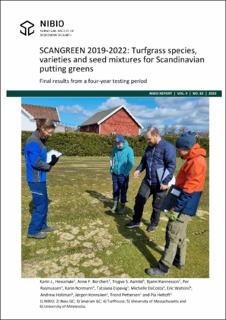SCANGREEN 2019-2022: Turfgrass species, varieties and seed mixtures for Scandinavian putting greens. Final results from a four-year testing period.
| dc.contributor.author | Hesselsøe, Karin Juul | |
| dc.contributor.author | Borchert, Anne Friederike | |
| dc.contributor.author | Aamlid, Trygve S. | |
| dc.contributor.author | Hannesson, Bjarni | |
| dc.contributor.author | Rasmussen, Per | |
| dc.contributor.author | Normann, Karin | |
| dc.contributor.author | Espevig, Tatsiana | |
| dc.contributor.author | DaCosta, Michelle | |
| dc.contributor.author | Watkins, Eric | |
| dc.contributor.author | Hollman, Andrew | |
| dc.contributor.author | Hornslien, Jørgen | |
| dc.contributor.author | Pettersen, Trond | |
| dc.contributor.author | Heltoft, Pia | |
| dc.date.accessioned | 2023-04-26T12:37:37Z | |
| dc.date.available | 2023-04-26T12:37:37Z | |
| dc.date.created | 2023-04-26T13:33:46Z | |
| dc.date.issued | 2023 | |
| dc.identifier.isbn | 978-82-17-03284-7 | |
| dc.identifier.uri | https://hdl.handle.net/11250/3065144 | |
| dc.description.abstract | The objective of SCANGREEN 2019-22 was to find species, varieties and seed blends/mixtures of Agrostis, Festuca, Poa and Lolium that are suited for pesticide-free management of putting greens in the two major climatic zones of the Nordic countries and in the northern USA. The four test sites in the Nordic countries were Reykjavik GC, Iceland and NIBIO Apelsvoll in the the northern zone, and NIBIO Landvik, Norway and Smørum GC, Denmark in the southern zone. The two US test sites were located at Troll Turfgrass Research Facility in Massachusetts and at University of Minnesota. The trials included 30 candidate varieties representing eight different species and subspecies from 13 different seed companies/representatives, and three seed mixtures of red fescue and colonial and creeping bentgrass, a seed mixture of creeping bentgrass and perennial ryegrass and a seed blend of red fescue. Monthly evaluations of overall impression, tiller density, winter hardiness, disease and weed coverage etc., were done from three weeks after sowing in June-September 2019 until October 2022. The trial at Smørum GC was established in May 2021. The trials were established according to a split-plot design with three blocks (replicates), species on main plots and varieties on subplots. The experimental greens were mown three times per week – Monday, Wednesday, and Friday and deficit-irrigated to 80% of field capacity three to four times per week in periods without sufficient natural rainfall. Fertilizer (mean N–P–K ratio, 100–22–74) was given as completely balanced compound fertilizers every second week. Each experimental green was divided in different management levels: High and low fertilizer rate and high and low mowing. The two fertilizer rates were 10 and 17 g N m−2 yr−1 and the two mowing heights were 3 and 5 mm. Mixtures were managed at both regimes. There was no use of pesticides or plant growth regulators in any of the trials. | |
| dc.description.abstract | SCANGREEN 2019-2022: Turfgrass species, varieties and seed mixtures for Scandinavian putting greens. Final results from a four-year testing period. | |
| dc.language.iso | eng | |
| dc.publisher | NIBIO | |
| dc.relation.ispartof | NIBIO Rapport | |
| dc.relation.ispartofseries | NIBIO Rapport | |
| dc.title | SCANGREEN 2019-2022: Turfgrass species, varieties and seed mixtures for Scandinavian putting greens. Final results from a four-year testing period. | |
| dc.title.alternative | SCANGREEN 2019-2022: Turfgrass species, varieties and seed mixtures for Scandinavian putting greens. Final results from a four-year testing period. | |
| dc.type | Research report | |
| dc.description.version | publishedVersion | |
| dc.source.pagenumber | 100 | |
| dc.source.volume | 9 | |
| dc.source.issue | 62 | |
| dc.identifier.cristin | 2143519 | |
| cristin.ispublished | true | |
| cristin.fulltext | original | |
| cristin.fulltext |
Tilhørende fil(er)
Denne innførselen finnes i følgende samling(er)
-
Divisjon for miljø og naturressurser [756]
Publikasjoner knyttet til ansatte ved Divisjon for miljø og naturressurser -
NIBIO RAPPORT [1499]
-
Publikasjoner fra CRIStin - NIBIO [4576]
